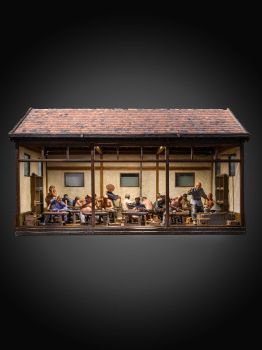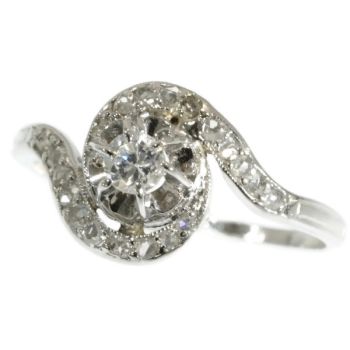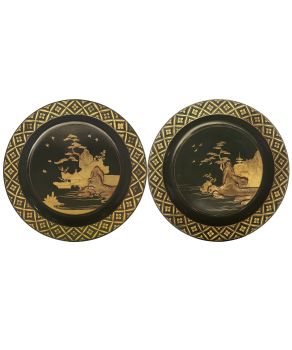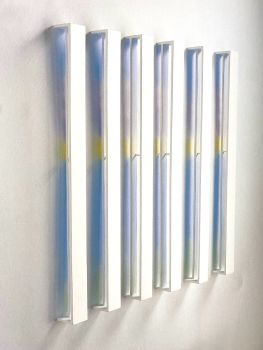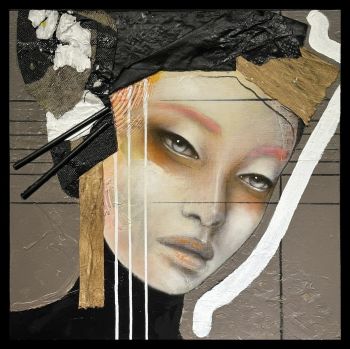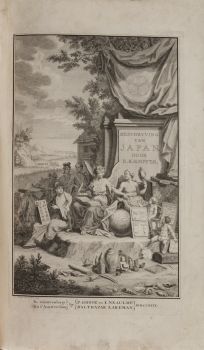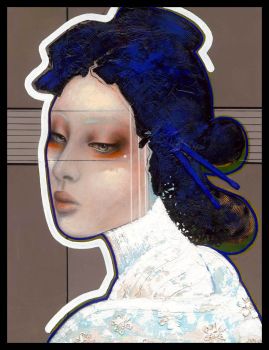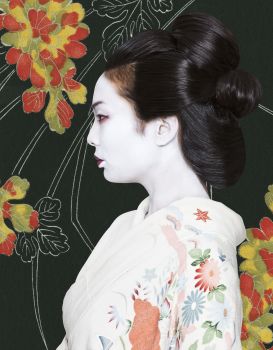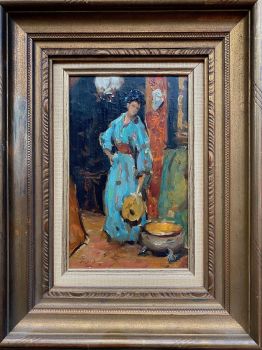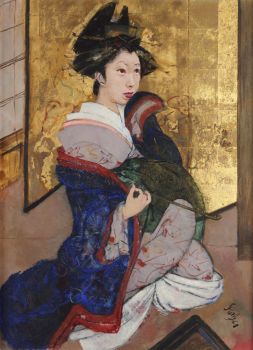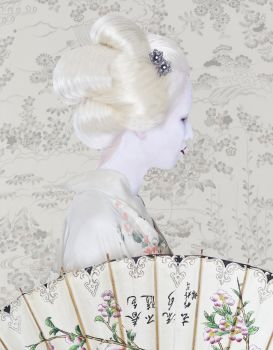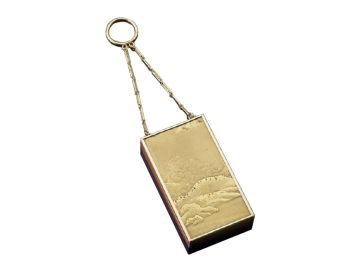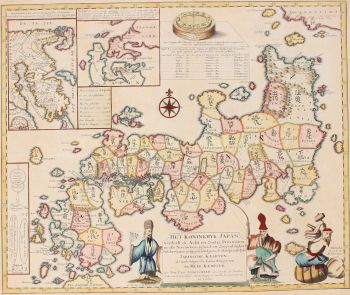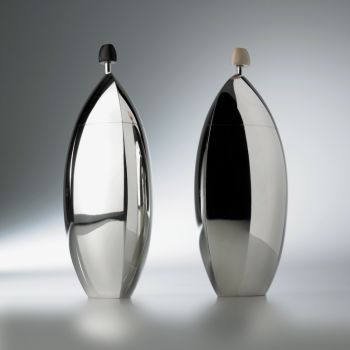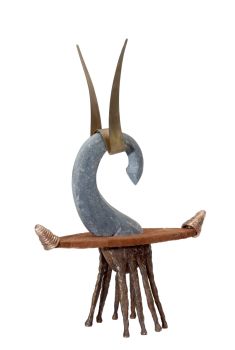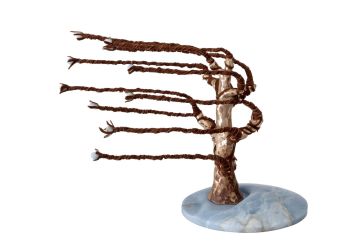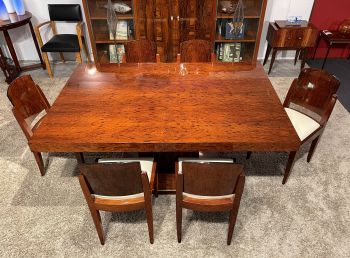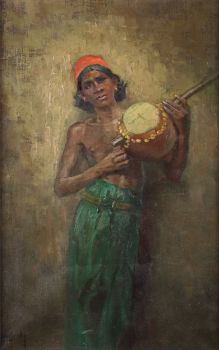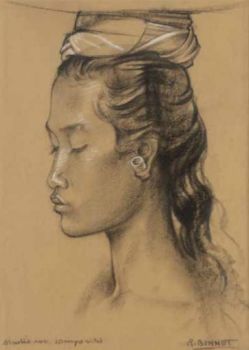UN RARO TELESCOPIO DE CUERO LACADO JAPONÉS GRANDE 1750 - 1800
Artista Desconocido
Cuero
Precio a consultar
Zebregs & Röell - Fine Art - Antiques
- Sobre la obra de arteA RARE LARGE JAPANESE LACQUERED LEATHER TELESCOPE
Edo Period, late 18th century
In four sections, the smaller innermost end fitted with a cow horn disc pierced with a central hole to maximise the use of the centre of the lens and the largest, outermost section finished with a copper disk with a central hole, all four sections of lacquered leather embossed and applied with gold lacquer on a black ground with bands of European style patterns including flowers, scrolling foliage and geometric designs, two covers for both ends.
L. 32 cm (retracted with the two end covers)
L, 87 cm (fully extended)
Note:
The first telescope to arrive in Japan was a gift from King James I (1566-1625) to the Shogun Tokugawa Ieyasu (1543-1616) in 1613. The Shogun made good use of his telescope during his battles and since then the Shogun and many of the country rulers asked the VOC, the Dutch East India Company based on the island of Deshima in the bay of Nagasaki, for telescopes as a tribute. At the end of the seventeenth century making of telescopes started in Japan, mainly in Nagasaki. The best known opticians during the Edo Period were Mori Nizaemon (1673-1754) of Nagasaki and Iwahashi Zenbei (1756-1811) of Osaka. The important role played by telescopes, of both European and Japanese manufacture, in the visual culture of the Edo Period is discussed in detail in Timon Screech, The Western Scientific Gaze and Popular Imagery in Later Edo Japan, (Cambridge, 1996).
For a similar example see NHK Service Centre and Siebold Council, Chikuzo 350-shunen Nagasaki Dejima ten (Exhibition commemorating the 350th anniversary of Deshima in Nagasaki, Tokyo and Osaka, 1986, cat. no. 134) for another example see Doris Croissant and Lothar Ledderose (eds.), Japan and Europe, 1543-1929 (pl. 61 in the exhibition catalogue: Berlin, Argon Verlag, 1993) there is an example in the Kobe Museum collection and two further examples of glass tube telescopes are in my catalogue Uit Verre Streken, Maastricht March 2015, cat. no. 59 and 60. - Sobre el artista
Puede suceder que un artista o creador sea desconocido.
Algunas obras no deben determinarse por quién está hecho o por (un grupo de) artesanos. Algunos ejemplos son estatuas de la Antigüedad, muebles, espejos o firmas que no son claras o legibles, pero también algunas obras no están firmadas en absoluto.
También puedes encontrar la siguiente descripción:
•"Atribuido a …." En su opinión, probablemente una obra del artista, al menos en parte.
•“Estudio de….” o “Taller de” En su opinión, una obra ejecutada en el estudio o taller del artista, posiblemente bajo su supervisión
•“Círculo de…” En su opinión, una obra del período del artista que muestra su influencia, estrechamente asociado con el artista pero no necesariamente su alumno.
•"Estilo de …." o “Seguidor de…”. En su opinión, una obra ejecutada al estilo del artista pero no necesariamente por un alumno; puede ser contemporáneo o casi contemporáneo
•"Manera de …." En su opinión una obra al estilo del artista pero de fecha posterior
•"Después …." En su opinión, una copia (de cualquier fecha) de una obra del artista
•“Firmado…”, “Fechado…” o “Inscrito” En su opinión, la obra ha sido firmada/fechada/inscrita por el artista. La adición de un signo de interrogación indica un elemento de duda.
•“Con firma…”, “Con fecha…”, “Con inscripción…” o “Lleva firma/fecha/inscripción” en su opinión la firma/fecha/inscripción ha sido añadida por alguien que no es el artista
¿Está interesado en comprar esta obra de arte?
Artwork details
Related artworks
- 1 - 4 / 12
Artista Desconocido
UN NETSUKE DE MARFIL DE UN HOLANDÉS CON UNA COCKEREL18th century
Precio a consultarZebregs & Röell - Fine Art - Antiques
Artista Desconocido
UN NETSUKE MARINE MARFIL DE UN HOLANDÉS CON UN VENTILADOR CHINO18th century
Precio a consultarZebregs & Röell - Fine Art - Antiques
Artista Desconocido
A rare Japanese export lacquer medical instrument box1650 - 1700
Precio a consultarZebregs & Röell - Fine Art - Antiques
Artista Desconocido
A Japanese bronze Hu flower vase, Edo / Meiji, 19th century19th century
Precio a consultarMenken Works of Art
Artista Desconocido
The Stamford Raffles Secretaires.1800 - 1813
Precio a consultarZebregs & Röell - Fine Art - Antiques
Artista Desconocido
UN PEQUEÑO NETSUKE DE MARFIL DE UN HOLANDÉS CON UN TAMBOR1750 - 1800
Precio a consultarZebregs & Röell - Fine Art - Antiques
1 - 4 / 22Artista Desconocido
UN MODELO JAPONÉS DE UN NORIMONO, UN PALANQUÍN1650 - 1700
Precio a consultarZebregs & Röell - Fine Art - Antiques
Artista Desconocido
A Japanese bronze Hu flower vase, Edo / Meiji, 19th century19th century
Precio a consultarMenken Works of Art
Artista Desconocido
UN PEQUEÑO NETSUKE DE MARFIL DE UN HOLANDÉS CON UN TAMBOR1750 - 1800
Precio a consultarZebregs & Röell - Fine Art - Antiques
Artista Desconocido
UNA COLECCIÓN DE CUATRO CAJAS BÍBLICAS DE MARFIL DE SRI LANKAN18th century
Precio a consultarZebregs & Röell - Fine Art - Antiques
Artista Desconocido
UN NETSUKE MARINE MARFIL DE UN HOLANDÉS CON UN VENTILADOR CHINO18th century
Precio a consultarZebregs & Röell - Fine Art - Antiques
Artista Desconocido
PAREJA DE ANTORCHAS O VELAS DE TECA DORADA Y LACADA INDONESIA18th century
Precio a consultarZebregs & Röell - Fine Art - Antiques
Artista Desconocido
EIGHT NEO-GOTHIC STAINED GLASS WINDOWS WITH SUSPENSION EYELET, 19th C, BELGIUM.1850 - 1900
Precio a consultarSpectandum Gallery
1 - 4 / 24Engelbert Kaempfer
LIBRO DE ENGELBERT KAEMPFER1651 - 1716
Precio a consultarZebregs & Röell - Fine Art - Antiques
Artista Desconocido
A large Japanese Imari porcelain 'VOC Groningen' dish1800 - 1925
Precio a consultarZebregs & Röell - Fine Art - Antiques
1 - 4 / 24- 1 - 4 / 18
Artista Desconocido
A rare Japanese export lacquer medical instrument box1650 - 1700
Precio a consultarZebregs & Röell - Fine Art - Antiques
HUGO VILFRED VON PEDERSEN
Gadesanger fra Singapore (Musician from Singapore)1870 - 1959
Precio a consultarZebregs & Röell - Fine Art - Antiques
Wolfgang Hugo Rheinhold
“Eritis sicut Deus”1900 - 1950
Precio a consultarZebregs & Röell - Fine Art - Antiques
Artista Desconocido
The Stamford Raffles Secretaires.1800 - 1813
Precio a consultarZebregs & Röell - Fine Art - Antiques
1 - 4 / 12








